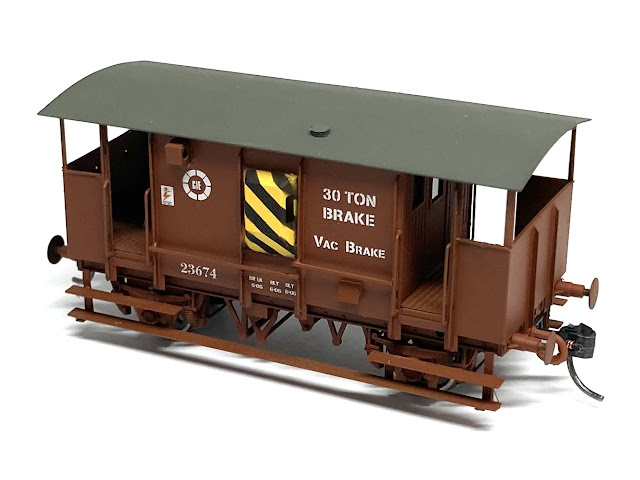No stopping the Irish adventure...
In my period of interest the humble brake van was still very much on the scene across Ireland. Despite some fantastic wagon announcements from Irish Railway Models this year there is still no sign of a ready to run offering leaving a few kit options to consider...
And there she is, un-weathered but with a consistent finish that goes across my existing 3 kit bashed vans and matches well with the out of the box finish on the Murphy 141 and IRM A class. Given time they'll all be weathered, but for now, posed with the short train I feel excited to see what is next in this Irish adventure. Until next time, more soon...
Until recently there were some lovely 3D printed kit / ready to run options from a chap in New Zealand but the cost to import these to the UK was prohibitive, even when they were available. That really just leaves the etched kit from Studio Scale Models of the larger 30 ton metal bodied example. An order was duly placed and after a few weeks a set of etches, wire and decals and instructions arrived from Des - to which I added a Dapol Prestwin chassis and some Accurascale buffers.
Whilst the instructions say superglue the thing together I thought I'd use solder for strength and it was a good opportunity for some skills practice. It largely fell together without too much trouble, the air remained singed only the fumes of flux and solder and no bad language or burnt flesh. I would take task with Des about the glued construction - I cannot see how that would result in a model of any real structural rigidity. The body is a one piece that folds up to form the rectangle - meaning one corner needs joining on the balcony. If this wasn't soldered I would fear it would always look a little rough, and be prone to unpeeling!
The footboards and handrails were soldered up to, the former then gluing to the Dapol chassis. 30g of weight was added inside the cabin and then the model primed with a mist of etch primer - left to go off for 10 minutes and then a coat of grey primer all over. I chose Humbrol 133 (no longer available, sadly) for the bodywork and this was airbrushed over the grey. As with the prototype this covered everything!
I masked the guards duckets as I had soldered these in place, and sprayed them with white primer and then yellow before masking the stripes and spraying black. The odd spot of overspray was tidied up with a brush and some more Humbrol 133. A cost of gloss lacquer as a base for the decals was added once the enamel had fully cured.
The supplied decals are a continuous sheet of backing paper so I cut them close to the markings and applied them with Micro-set and Micro-sol. Once all in place, a bit of guesswork really for this non-Irish modeller, I sealed the model with a dull satin lacquer. The roof was rolled to shape, primed and the sprayed with a dark grey. Glazing was added to the ends and the roof secured with glue-n-glaze canopy glue should it ever need to be removed.
Donate
I love writing and creating material for the blog. If you enjoy what you read and engage with I would be appreciative of any donation, large or small, to help me keep it advert and restriction free.







Nicely done!
ReplyDeleteDo you know if there are any drawings/plans available for CIE stock of that era? Something like that brake van might be a nice scratchbuild in plastic.
Alan I have no idea I’m afraid, good luck! I like supporting kit manufacturers when possible, probably as I’m one myself. A styrene scratchbuild of this or similar design would be very possible indeed.
Delete